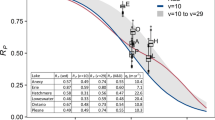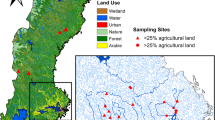Abstract
The empirical adequacy of four phosphorus mass-balance models is evaluated with respect to how the prediction error variance of the corresponding net sedimentation parameters is propagated in the steadystate equations. Using the criterion of minimum propagation error variance (PEV), different groups of lakes can be distinguished for which different empirical equations are used to predict net phosphorus sedimentation. The classification reduced prediction error significantly and also reflected different patterns of sedimentation. Application of this criterion to time-series of individual lakes shows that it is possible to determine a priori whether net annual sedimentation will be better correlated to the annual loading or to the lake content. The correlations depended also on the load/lake content ratio, suggesting that net sedimentation is best viewed as the sum of the partial sedimentation of the load and of the partial sedimentation of the lake content. On average, 25% of the load and 18% of the lake content are sedimented annually. Viewing net phosphorus sedimentation as a function of both the load and the lake content can also explain and predict the well-known cross-sectional correlation between phosphorus retention and water residence time.
Similar content being viewed by others
References
Benjamin, J. R., C. A. Cornell, 1970, Probability, statistics and decision for civil engineers, McGraw-Hill, New York.
Chapra, S. C., 1975, Comment on: “An empirical method of estimating the retention of phosphorus in lakes” by W. B. Kirchner and P. J. Dillon, Water Resour. Res. 2: 1033–1034.
Chapra, S. C., K. H. Reckhow, 1983, Comment on: “The effect of changes in the nutrient income on the condition of Lake Washington” by W. T. Edmondson and J. T. Lehman. Limnol. Oceanogr. 28: 792–795.
CIPEL, 1984, Le Léman, synthèse 1957–1982. Report of the Commission internationale pour la protection des eaux du Léman contre la pollution. 650 p.
Dillon, P. J., W. B. Kirchner, 1975, Reply to comment by Chapra. Water Resour. Res. 2: 1035–1036.
Dillon, P. J., F. H. Rigler, 1974, A test of a simple nutrient budget model predicting the phosphorus concentration in lake water. J. Fish. Res. Board Can. 31: 1771–1778.
Edmondson, W. T., J. T. Lehman, 1981, The effects of changes in the nutrient income on the condition of Lake Washington. Limnol. Oceanogr. 26: 1–29.
Gächter R., 1987, Lake restoration. Why oxygenation and artificial mixing cannot substitute for a decrease in the external phosphorus loading. Schweiz. Z. Hydrol. 49: 170–185.
Gächter, R., D. Imboden, 1985, Lake restoration.In: W. Stumm (ed.), Chemical processes in lakes, Wiley and Sons, New York.
Gächter, R., D. Imboden, H. Bührer, P. Stadelmann, 1983, Mögliche Maßnahmen zur Restaurierung des Sempachersees. Schweiz. Z. Hydrol. 45: 246–266.
Golterman, H. L., F. A. Kouwe, 1980, Chemical budgets and nutrient pathways.In: E. D. Lecren, R. h. Lowe-McConnell (eds.), The Functioning of freshwater ecosystems, IBP Handbook 22, Blackwell Publishers, pp. 85–140.
Imboden, D., 1974, Phosphorus model of lake eutrophication. Limnol. Oceanogr. 19: 297–304.
Janus, L. L., R. A. Vollenweider, 1984, Phosphorus residence time in relation to trophic conditions in lakes. Verh. Internat. Verein. Limnol. 22: 179–184.
Kleiner, J., 1988, Co-precipitation of phosphate with calcite in lake water: a laboratory experiment modelling phosphorus removal with calcite in Lake Constance. Water Res. 22: 1259–1265.
Kirchner, W. B., P. J. Dillon, 1975, An empirical method of estimating the retention of phosphorus in lakes. Water Resour. Res. 11: 182–183.
Larsen, D. P., H. T. Mercier, 1976, Phosphorus retention capacity of lakes. J. Fish. Res. Board Can. 33: 1742–1750.
Lerman, A., A. B. Hull, 1987, Background aspects of lake restoration: water balance, heavy metal content, phosphorus homeostasis. Schweiz. Z. Hydrol. 49: 148–169.
Nürnberg, G. K., 1984, The prediction of internal phosphorus loads on lakes with anoxix hypolimnia. Limnol. Oceanogr. 29: 111–124.
OECD, 1982, Eutrophication of waters. Monitoring, assessment and control. Paris, 154 p.
Prairie, Y. T., 1988, A test of the sedimentation assumptions of phosphorus input-output models. Arch. Hydrobiol. 111: 321–327.
Reckhow, K. H., 1977, Phosphorus models for lake management. Ph. D. thesis. Harvard University, Boston.
Reckhow, K. H., S. C. Chapra, 1983, Engineering approaches for lake management. Volume 1: Data analysis and empirical modeling. Butterworth Publishers.
Schindler, D. W., 1985, The coupling of elemental cycles by organisms: evidence from whole-lake perturbations.In: W. Stumm (ed.), Chemical processes in lakes, J. Wiley and Sons, New York.
Snodgrass, W. J., P. J. Dillon, 1983, A test of two models of different complexity for predicting changes of phosphorus concentration in a lake's outflow. Ecol. Modelling 19: 163–187.
Stabel, H.-H., 1984, Impact of sedimentation on the phosphorus content of the euphotic zone of Lake Constance. Verh. Internat. Verein. Limnol. 22: 964–969.
Vollenweider, R. A., 1969, Möglichkeiten und Grenzen elementarer Modelle der Stoffbilanz von Seen. Arch. Hydrobiol. 66: 1–36.
Vollenweider, R. A., 1976, Advances in defining critical loading levels for phosphorus in lake eutrophication. Mem. Ist. Ital. Idrobiol. 33: 53–83.
Vollenweider, R. A., 1987, Scientific concepts and methodologies pertinent to lake research and lake restoration. Schweiz. Z. Hydrol. 49: 129–147.
Wagner, G., 1976, Simulationsmodelle der Seeneutrophierung, dargestellt am Beispiel des Bodensee-Obersees. Teil II: Simulation des Phosphorhaushaltes des Bodensee-Obersees. Arch. Hydrobiol. 78: 1–41.
Walker, W. W., 1982, Empirical methods for predicting eurtrophication in impoundments. Report 2, Phase II: model testing. Technical report E-81-9, U. S. Army Engineer Waterways Experiment Station, Vickburg.
Author information
Authors and Affiliations
Rights and permissions
About this article
Cite this article
Prairie, Y.T. Statistical models for the estimation of net phosphorus sedimentation in lakes. Aquatic Science 51, 192–210 (1989). https://doi.org/10.1007/BF00877742
Received:
Accepted:
Issue Date:
DOI: https://doi.org/10.1007/BF00877742




